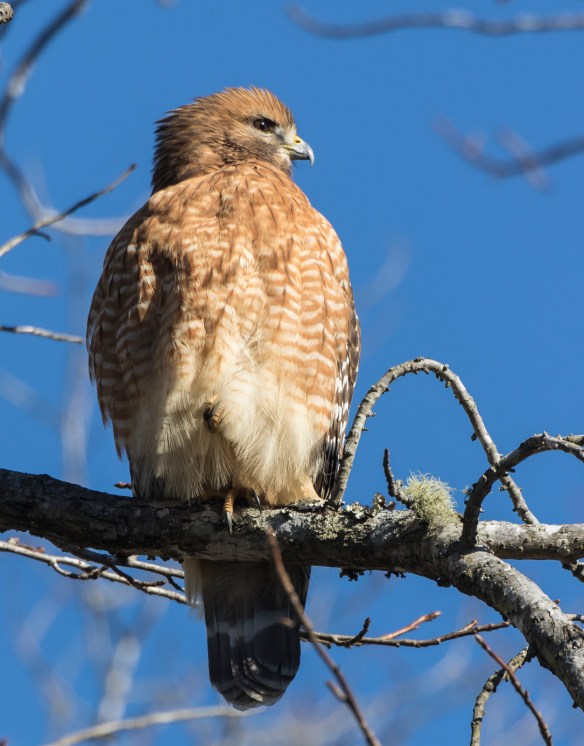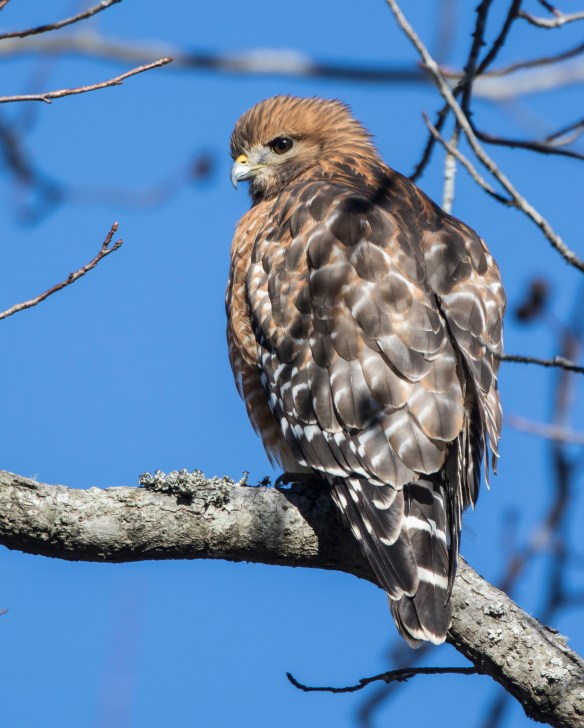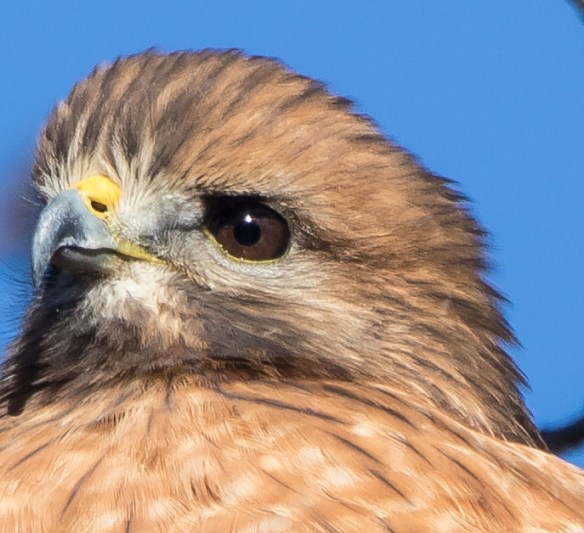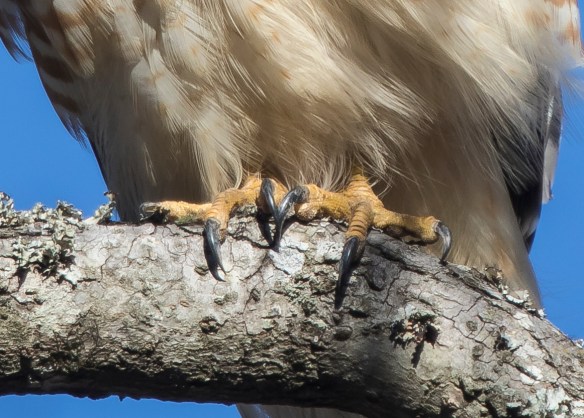The sparrow flying behind the hawk thinks the hawk is fleeing.
~Japanese proverb
Last Saturday, I had the opportunity to work with my friend, Mary, to provide an introductory bird photography class at the NC Botanical Garden (NCBG) in Chapel Hill. It was next to the last in a series of programs that were part of the Saving Our Birds program initiative the Garden has sponsored this year. For part of the program, we went outside into the brisk morning air, spending time in their very active bird blind area, and the rest of the time walking around the native plant display gardens, looking for birds to photograph. The highlight of the day was a beautiful red-shouldered hawk (Buteo lineatus), that was most obliging to our group.
Red-shouldered hawks are medium-sized buteos (soaring hawks) easily recognized by their rusty, barred breast, and the bold black-and-white bands on their tail. Immature birds are a bit tougher to identify – their tail is dark brown with several narrow brown bars and they have a pale breast with thick dark streaking that somewhat resembles several other common raptors. The area around the display gardens at NCBG has been home to at least one pair of red-shouldered hawks for several years. They seem well-adjusted to the comings and goings of people at the Garden. This one was perched in a tree near the building complex for much of the morning and early afternoon. This allowed our class to photograph it from many angles so we could try to avoid the cluster of twigs and branches that surrounded the hawk. The light was perfect and the bird cooperative, a perfect scenario for photographers.
After the program, I went back out to the tree with my 500mm lens and spent over an hour with this beautiful bird, watching it, and taking way too many photos. I appreciated the chance to simply observe this raptor and take notice of its many traits and adaptations. The light was so rich that I could clearly see the reddish colors of their shoulder feathers that gives this species its common name.
The feature that stood out for me was its eyes…so intense, so fierce. According to several online resources, raptors can see anywhere from four to eight times better than the average human. This is accomplished by a couple of adaptations. The eyes of a hawk are proportionally larger than a human eye, occupying some 10-15% of the weight of the head, compared to about 1% in humans. Hawks also have more concentrated areas of rods and cones than we do, giving them higher resolution (sharper) vision. They have two fovea (one central and one peripheral) compared to just a central one in humans. The fovea is the spot on the back of our eye with the highest concentration of rods and cones.
Like us, raptors have binocular vision, with the eyes placed facing forward on the head. This allows them (and us) to judge distances better and to focus on something with both eyes at once. Hawks can also reportedly perceive more colors than us, and can also see ultraviolet light (which may help in tracing urine trails of small mammals in vegetation).
A bird also have some extra protection for their eye, a third eyelid called a nictitating membrane. This is a thin, translucent membrane that is used for protecting, lubricating, and cleaning the eye. A bird can still see when this membrane covers the eye, whereas we cannot when our eyelid closes. Birds also have a moveable upper and lower eyelid. The upper eyelid moves downward when a bird blinks. The lower eyelid moves upward when a bird sleeps. The nictitating membrane moves horizontally across a bird’s eye, sweeping from front to back. Based on my afternoon of hawk-watching, birds must use the nictitating membrane much more frequently than they do their upper eyelid. I took about 680 images (see what I mean, way too many) of the hawk that afternoon and captured 6 sweeps with the nictitating membrane, and no blinks with the upper eyelid.
Red-shouldered hawks feed on a variety of prey including reptiles, amphibians, and small mammals. Their feet and talons are used to capture and hold struggling prey.
Hawks have sharp, hooked beaks used to grab prey, pull off fur, skin, or feathers, and tear the meat into bite-sized chunks. I kept hoping this hawk would sail down to capture something, but all it did was occasionally focus on some unseen item of interest in the vegetation around me.
In addition to watching everything around it, the hawk occasionally did what all birds spend a lot of time doing – preening its beautiful feathers. Preening is accomplished by running the feathers through the talons or beak, gently pulling and realigning feathers for their optimum condition. This feather grooming can also help rid them of parasites, debris, and make them look their best for attracting mates. Mutual preening is also a part of the courtship ritual in some species.
I suppose it is fitting that toward the end of my time with my hawk, I witnessed the other end of the meal process, its elimination. After stretching its wings, the hawk leaned forward, raised its tail, and let fly with a white mass of bird poop that shot downward with considerable force. I often see them do this right before taking flight (it makes sense to lighten the load before take-off). Maybe this was just a commentary on my presence (or perhaps current events), but I decided to take the hint and pack up my camera and tripod and let the hawk go about its business for the rest of the afternoon. But I will be back and will photograph it again, hoping to capture some more behavior of this regal “garden” bird.

















